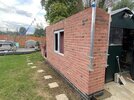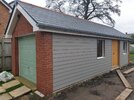Having never built anything before I decided to build a new house by myself . However after the wife had her say I decided to scale down my plans and opted to build a new garage instead . but to make things more difficult I decided to build it around the existing metal garage as I can’t remove it until the new garage is close to finished as I’ve got a car in the process of being restored in it along with lots of tools etc .
Anyway it’s going well but squaring it off and finding the levels was a bitch but it looks quite good so far ,bricklaying isn’t as hard as I thought it would be .
I will soon be getting to the roof after I’ve built the gables which will be built and tiled by myself and I heard ridge tiles can no longer be cemented downand must be dry fixed . Is that true and if so is it the case for all buildings or only those which are lived in . Do I need to do it on a garage
Anyway it’s going well but squaring it off and finding the levels was a bitch but it looks quite good so far ,bricklaying isn’t as hard as I thought it would be .
I will soon be getting to the roof after I’ve built the gables which will be built and tiled by myself and I heard ridge tiles can no longer be cemented downand must be dry fixed . Is that true and if so is it the case for all buildings or only those which are lived in . Do I need to do it on a garage



